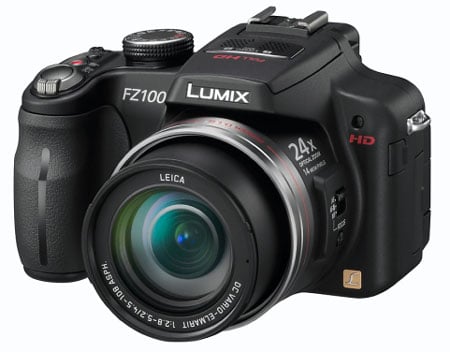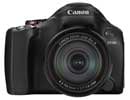Panasonic Lumix DMC-FZ100
-
-
Written by Gordon Laing
Verdict
The Panasonic Lumix FZ100 is the highly anticipated successor to the best-selling Lumix FZ38 / FZ35 – or to be more accurate one of two successors, the other being the more affordable FZ45 / FZ40.
For the FZ100, Panasonic has replaced the FZ38 / FZ35’s 12 Megapixel CCD with a MOS sensor sporting an increased resolution of 14 Megapixels. The switch to MOS technology allows the FZ100 to offer 1080i HD video shooting along with a raft of high speed burst shooting modes that exceed the capabilities of many modern DSLRs. The zoom has been extended from 18x to 24x, providing a little extra at the wide angle end and more telephoto reach with a 25-600mm equivalent range. The LCD panel has been upgraded to 3in with 460k pixels and is now fully articulated. The FZ100 also gets a hotshoe so you can use an external flash, and an input for an external microphone.
Beyond the headline improvements there’s a raft of other changes that improve the overall handling not least of which is the rearrangement of the physical controls and the move from a switch to a button for selecting shooting or playback modes. The movie recording button has been moved to the top panel, the lens hood has been redesigned with a new bayonet fixing and there’s now the option to shoot fine quality JPEGs with RAW files.
All of this puts the Lumix FZ100 in a very strong position to compete against Canon’s PowerShot SX30 IS at a similar price point. But if you’re on a budget and can live without some of the FZ100’s premium features, the considerably cheaper FZ45 / FZ40, with the same lens, a 14 Megapixel CCD sensor and a fixed 3 inch screen, might prove a better choice. Let’s see how they compare.
 |
Compared to Panasonic Lumix FZ45 / FZ40
Anybody holding off buying the FZ38 / FZ35, waiting to see what the new model has to offer will have been pleasantly surprised by Panasonic’s bold move to replace one model with two. The question is which one to go for? Both cameras are very similar in terms of size, weight, styling and handling, essentially the same model with a different feature set. So you need to decide what features are important to you and whether it’s worth the significant price saving to do without them. The lens is exactly the same on both models, the primary differences are the sensor, the FZ100’s flip out screen and the hot shoe.
The FZ100’s MOS sensor means it can shoot 1080i HD video which, on it’s own may not be sufficient cause for the extra cash outlay. But it can also shoot high speed QVGA video and take stills while recording. In addition the FZ100 has far better burst shooting capabilies than the FZ45 / FZ40, so if you like to shoot sports and fast-moving action subjects that could decide it for you.
The one disappointment with the Lumix FZ100 is the quality of the still images produced by its 14 Megapixel MOS sensor. The 100 percent crops from our test shots were soft, noisy and lacking in detail by comaprison with those from the FZ45 / FZ40’s CCD sensor. It’s worth remembering, though, that you rarely look at images this closely and unless you display these images on a big screen or print them larger than A3 size, you’re unlikely no notice a big difference. You can also improve the JPEG image quality on the FZ100 by changing the noise reduction and sharpness settings or shooting RAW.
But if you can live without the articulated screen, flash hotshoe, fast burst shooting and 1080i video, the FZ45 / FZ40 becomes the better choice as it’s cheaper, while delivering superior image quality with the default settings. It’s a great value super-zoom camera. See our Panasonic Lumix DMC-FZ45 / FZ40 review for details.
Compared to Canon PowerShot SX30 IS
The stand-out advantage provided by the PowerShot SX30 IS’s 35x optical zoom lens is hard to understate. At the wide-angle end of the range there’s little in it with the two cameras delivering virtually identical coverage, but an 840mm telephoto will get you a lot closer to the action than a 600mm, so if you shoot a lot of very distant subjects, this alone will probably be enough to decide you in the PowerShot SX30 IS’s favour.
The PowerShot SX30 IS is bigger and heavier than the Lumix FZ100 though and it’s battery doesn’t last as long, but we did prefer the SX30 IS styling. The layout of the physical controls is cleaner, neater and simpler than the proliferation of switches and buttons on the Lumix FZ100. The simplicity of layout extends to the Canon menu system with its hints and tips system. Much of this is subjective however and, as always, we’d recommend you get your hands on both models before making a buying decision.
Both cameras feature articulatred screens, but the Lumix FZ100’s is slightly bigger and wider, while sporting twice as many pixels, factors which make a big difference when shooting 16:9 video. The FZ100 can also shoot 1080i HD video, but the ability to use the PASM exposure modes for filming along with connecting an external microphone are likely to be more of a pull for videophiles. The PowerShot SX30 IS is limited to 720p HD recording and Progam auto exposure mode with Scene detection.
The FZ100’s final trump card is the range of high speed burst modes courtesy of its MOS processor. The PowerShot SX30 IS’s continuous shooting performance can only be described as mediocre by comparison. And let’s not forget the FZ100 can also shoot RAW.
This comparison wouldn’t be complete though without mentioning the gap in image quality between the PowerShot SX30 IS and Lumix FZ100. You’ll need to look at our outdoor and high ISO comparisons and make your own mind up, but for us the image quality of the PowerShot SX30 IS is demonstrably superior to that of the Lumix FZ100. Couple that with the monstrously long zoom range, and the Canon is hard to resist. See our Canon PowerShot SX30 IS review for more details.
Panasonic Lumix DMC-FZ100 verdict
The Lumix FZ100 improves on its predecessor, the FZ38 / FZ35, in a number of key respects. Firstly, there’s the increased zoom range. In the shadow of the PowerShot SX30 IS it’s easy to underestimate the FZ100’s new 24x optical range. It may not be quite as wide or long as the Canon’s vast zoom, but it is wider and much longer than the earlier FZ38 / FZ35, while the 600mm maximum is more than sufficient for most subjects.
The new 3in / 460k screen provides a much better view for filming 16:9 HD movies and the articulated mount makes it easy to shoot at high or low angles. Despite having a larger, higher resolution screen than the SX30 IS, the FZ100 also manages to squeeze more shots from its battery. 1080i HD video is another welcome improvement, as are the additions of a flash hotshoe and microphone input, but it’s the burst shooting modes which really impress, providing the kind of performance that puts many DSLRs in the shade.
At this point it sounds like Panasonic’s got a slam dunk. For several generations it pitched one FZ super-zoom against one Canon SX super-zoom, but resisted the temptation to fit a hotshoe and articulated screen in order to maintain the smaller body and lower price. But now it’s made the very cunning decision to offer not one, but two versions: there’s the cheaper FZ45 / FZ40 which continues the strategy of the older models, but it’s now joined by the new FZ100 which delivers a premium version at a higher price.
Now Canon no longer has the only super-zoom with a hotshoe and articulated screen. Panasonic’s equipped the FZ100 with both, while also increasing the screen size and resolution, fitting a microphone input, boosting the maximum movie quality to 1080i, and allowing very quick burst shooting modes of up to 11fps at the full resolution. Throw in manual control over exposures in the movie mode, along with continued support for RAW recording and you’ve got a truly feature-packed super-zoom camera for much the same price as the SX30 IS. Take that Canon!
Even considering the longer zoom range of the Canon, this feature-set should arguably make the FZ100 the best super-zoom camera on the market, but there is a problem. The one disappointing aspect of the FZ100 is its image quality which throughout the ISO range is soft and lacking detail. Side-by-side against the SX30 IS, FZ45 / FZ40 and even the older FZ38 / FZ35, it looks soft and smeared-out. As we found in our results pages, it’s possible to alleviate this by reducing the noise reduction and boosting the sharpness, but this is a strategy that’s best-reserved for the lowest sensitivity.
The fact is the FZ100 has a noisier sensor than both the FZ45 / FZ40 and Canon SX30 IS, not to mention the earlier FZ38 / FZ35, and you either have to tweak the settings and accept obvious speckles especially as the sensitivity increases, or stick with the defaults and suffer from smearing as the camera applies its overly-aggressive noise reduction.
This is an issue many won’t be able to ignore, and if you’re one of them who still wants a super-zoom with an articulated screen and flash hotshoe (albeit without the quick burst shooting and 1080i video), then the PowerShot SX30 IS becomes the obvious choice. If you want to save some money though and can get by without an articulated screen, flash hotshoe, fast burst shooting and 1080i video, then the FZ45 / FZ40 becomes a better option. That may sound like a lot to leave out, but you’re still getting the same 24x optical zoom packed into a relatively small and light body at a great price.
If you can live with the FZ100’s image quality though (or are happy to tweak the settings), it’s undoubtedly a very impressive camera, and don’t forget while the MOS sensor is responsible for these problems, it’s also the technology behind the 1080i video and very quick burst shooting. Sadly you still can’t have it all. The choice is yours, but make sure you understand the FZ100’s limitations before buying on specification alone. We can recommended it, but with reservations.
Bad points | Scores (relative to 2010 super-zooms) |
 | ||
Build quality: Image quality: Handling: Specification: Value:
Overall: |
18 / 20 13 / 20 17 / 20 19 / 20 17 / 20
84% | |||






